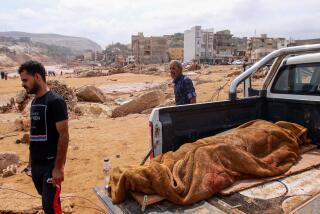Opposition to Kadafi Growing in Libya, Abraod
- Share via
CAIRO — Libyan leader Moammar Kadafi is facing growing resistance to his rule from opposition groups both inside and outside Libya, according to intelligence sources and Libyan dissidents.
While there is no suggestion yet that such resistance seriously threatens his power, intelligence sources say there are indications that his regime is deeply concerned about the political agitation, which last month erupted into violent protests in four Libyan cities and, according to some reports, at least one major army base.
“Never before has the dissatisfaction with Kadafi been so evident as it is now,” said one intelligence source, who monitors Libya closely.
According to the reports filtering out of Libya, clashes between demonstrators and security forces took place last month in the coastal cities of Benghazi and Surt, where the head of the local branch of Kadafi’s Revolutionary Committees was reportedly killed. Smaller demonstrations occured in Tripoli and Al Bayda, a town northeast of Benghazi.
Egyptian military sources said a mutiny also took place at the military base in Tobruk, 75 miles northwest of the Egyptian border, but they said they had no other details.
Although the unrest appears to have been contained, Libya watchers in Cairo consider it to be highly significant that anti-government demonstrations took place more or less simultaneously in several Libyan cities.
“One of Col. Kadafi’s greatest assets is geography,” a senior Egyptian military source said. “Libya is a very disconnected country geographically in that its population centers are far apart and isolated from each other, and this has made it difficult for Kadafi’s opponents to coordinate anything.
“But last month we saw demonstrations break out in several places at once,” he added. “This has never happened before.”
Recent interviews with intelligence officials, diplomats and Libyan dissidents inside and outside the country suggest that there are several reasons for the rise in open dissent.
One was Kadafi’s unpopular military intervention in Chad two years ago, which is said to have led to a large number of desertions from Libya’s 70,000-member armed forces. The Chad debacle has come back to haunt Kadafi, the sources said. Many of those deserters, together with captured soldiers since released by the Chadians, have been reorganized into an anti-Kadafi military force led by the former commander of the Libyan forces in Chad, Col. Abdoulgassim Khalifa Hafter.
The Libyan “contras,” as they are calling themselves, are receiving what is believed to be U.S.- and French-assisted training in Chad and have set up a radio station that broadcasts across Libya.
Little Military Success
They have no military success to boast of yet--hit-and-run guerrilla tactics in the open desert are not as effective as in the jungle--but their presence seems to have encouraged other dissidents in Libya.
“The ‘contra’ broadcasts are the most popular radio program in Libya,” said one student dissident, who could not be identified further because he lives in Libya. “Everyone is glad there is an anti-Kadafi force being formed and trained now. A lot of people would join them if they could.”
The creation of a rebel force has also been an encouragement to the long-established but relatively ineffective Libyan opposition in exile. One of the exile groups, the National Front for the Salvation of Libya, has allied itself with Hafter’s forces and now expects to be more effective in opposing Kadafi in the future, according to its leader, Dr. Mohammed al Magarif.
Kadafi unintentionally gave another boost to the opposition last year when he declared a general amnesty and released about 7,000 prisoners from Libyan jails. Many of those freed under the amnesty were political prisoners and many of them have since become active again in opposing Kadafi, the student and other sources said.
At the same time, Kadafi’s moves to curb the influence and excesses of his much-feared Revolutionary Committees have given the dissidents slightly more room to maneuver.
A third and more noticeable factor fueling the current unrest in Libya, diplomats say, is a resurgence of Islamic fundamentalism. While Islamic revivalism, as its proponents prefer to call it, is not a new phenomenon in Libya, years of fierce repression had driven it deeply underground. But with the loosening of domestic controls last year, it has resurfaced in a more militant form, the diplomats said.
Most of the clashes with security forces last month involved fundamentalists, an Egyptian intelligence official said.
The most serious of these apparently took place in Surt, 230 miles southeast of Tripoli, between security forces and members of the Muslim Brotherhood.
“According to our information, the troubles began in Surt on Jan. 17 and continued off and on for 10 days,” the source said. “There were apparently several clashes with the Muslim Brotherhood that ended in exchanges of gunfire.”
Among the casualties during this period were the head of the Revolutionary Committees in Surt, his deputy and army captain who, according to the intelligence reports cited by this source, were assassinated by the fundamentalists.
Western diplomats who monitor Libya said they could not confirm these reports, but they added that they did hear of other demonstrations at about the same time on the campus of Fateh University in Tripoli.
Most of these demonstrations, which involved students from the faculties of engineering, science, pharmacology and agriculture, also appear to have been fundamentalist-inspired, the diplomats said.
“Fundamentalism is finally starting to pose problems for Kadafi, as it has been doing elsewhere in the region,” the military intelligence source said.
Most analysts caution that none of this means that Kadafi’s 19-year grip on Libya is in danger of slipping.
More to Read
Sign up for Essential California
The most important California stories and recommendations in your inbox every morning.
You may occasionally receive promotional content from the Los Angeles Times.













